Tesla: Supplier Performance Gap Analysis and Improvement Strategies
VerifiedAdded on 2020/12/09
|51
|19109
|457
Thesis and Dissertation
AI Summary
This thesis investigates the performance of Tesla's suppliers, focusing on identifying and resolving performance gaps related to cost, quality, and capacity. The introduction establishes the background and rationale for the research, emphasizing the critical role of supply chain management in the automotive industry. The literature review explores various themes, including the role of supply chain management, factors contributing to performance gaps, and strategies for improvement. The research methodology outlines the approach, design, and data analysis techniques used. The data analysis chapter presents findings on the role of supply chain management, factors leading to performance gaps, and strategies to mitigate them. The thesis concludes with a discussion of the findings, offering insights into enhancing supplier efficiency and providing recommendations for future research and practical implementation within the automotive sector. The study uses Tesla as a case study to analyze real-world scenarios and challenges faced in the industry.
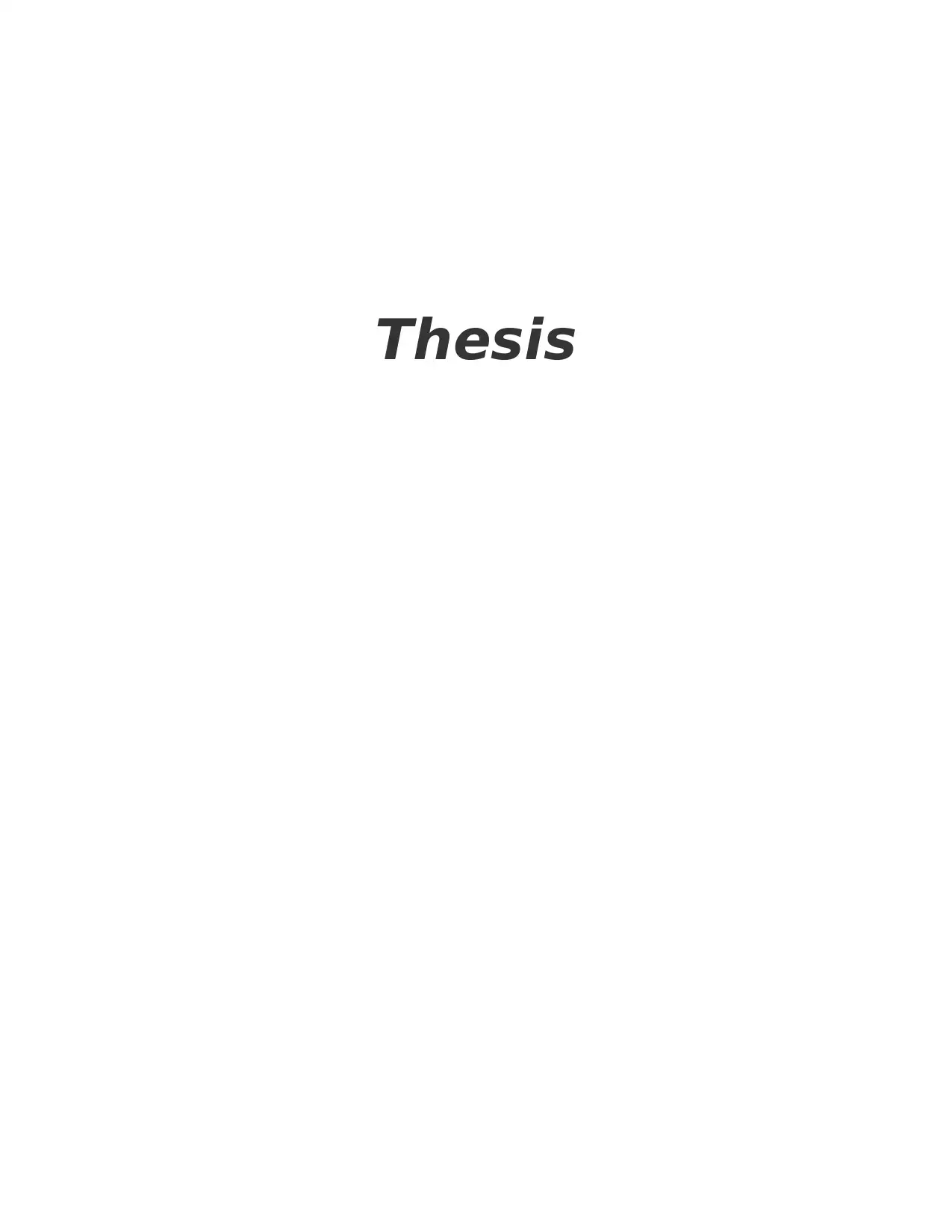
Thesis
Paraphrase This Document
Need a fresh take? Get an instant paraphrase of this document with our AI Paraphraser
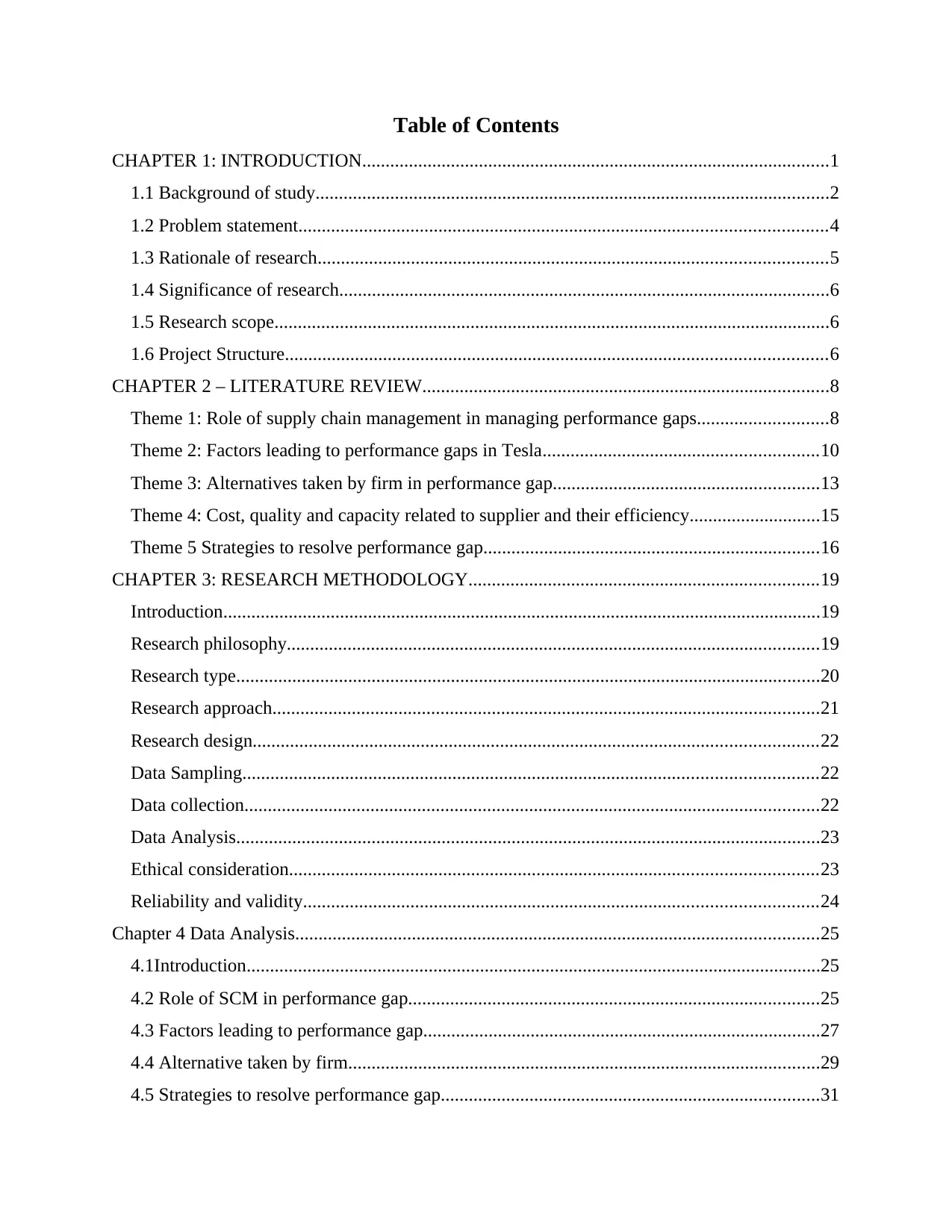
Table of Contents
CHAPTER 1: INTRODUCTION....................................................................................................1
1.1 Background of study..............................................................................................................2
1.2 Problem statement.................................................................................................................4
1.3 Rationale of research.............................................................................................................5
1.4 Significance of research.........................................................................................................6
1.5 Research scope.......................................................................................................................6
1.6 Project Structure....................................................................................................................6
CHAPTER 2 – LITERATURE REVIEW.......................................................................................8
Theme 1: Role of supply chain management in managing performance gaps............................8
Theme 2: Factors leading to performance gaps in Tesla...........................................................10
Theme 3: Alternatives taken by firm in performance gap.........................................................13
Theme 4: Cost, quality and capacity related to supplier and their efficiency............................15
Theme 5 Strategies to resolve performance gap........................................................................16
CHAPTER 3: RESEARCH METHODOLOGY...........................................................................19
Introduction................................................................................................................................19
Research philosophy..................................................................................................................19
Research type.............................................................................................................................20
Research approach.....................................................................................................................21
Research design.........................................................................................................................22
Data Sampling...........................................................................................................................22
Data collection...........................................................................................................................22
Data Analysis.............................................................................................................................23
Ethical consideration.................................................................................................................23
Reliability and validity..............................................................................................................24
Chapter 4 Data Analysis................................................................................................................25
4.1Introduction...........................................................................................................................25
4.2 Role of SCM in performance gap........................................................................................25
4.3 Factors leading to performance gap.....................................................................................27
4.4 Alternative taken by firm.....................................................................................................29
4.5 Strategies to resolve performance gap.................................................................................31
CHAPTER 1: INTRODUCTION....................................................................................................1
1.1 Background of study..............................................................................................................2
1.2 Problem statement.................................................................................................................4
1.3 Rationale of research.............................................................................................................5
1.4 Significance of research.........................................................................................................6
1.5 Research scope.......................................................................................................................6
1.6 Project Structure....................................................................................................................6
CHAPTER 2 – LITERATURE REVIEW.......................................................................................8
Theme 1: Role of supply chain management in managing performance gaps............................8
Theme 2: Factors leading to performance gaps in Tesla...........................................................10
Theme 3: Alternatives taken by firm in performance gap.........................................................13
Theme 4: Cost, quality and capacity related to supplier and their efficiency............................15
Theme 5 Strategies to resolve performance gap........................................................................16
CHAPTER 3: RESEARCH METHODOLOGY...........................................................................19
Introduction................................................................................................................................19
Research philosophy..................................................................................................................19
Research type.............................................................................................................................20
Research approach.....................................................................................................................21
Research design.........................................................................................................................22
Data Sampling...........................................................................................................................22
Data collection...........................................................................................................................22
Data Analysis.............................................................................................................................23
Ethical consideration.................................................................................................................23
Reliability and validity..............................................................................................................24
Chapter 4 Data Analysis................................................................................................................25
4.1Introduction...........................................................................................................................25
4.2 Role of SCM in performance gap........................................................................................25
4.3 Factors leading to performance gap.....................................................................................27
4.4 Alternative taken by firm.....................................................................................................29
4.5 Strategies to resolve performance gap.................................................................................31
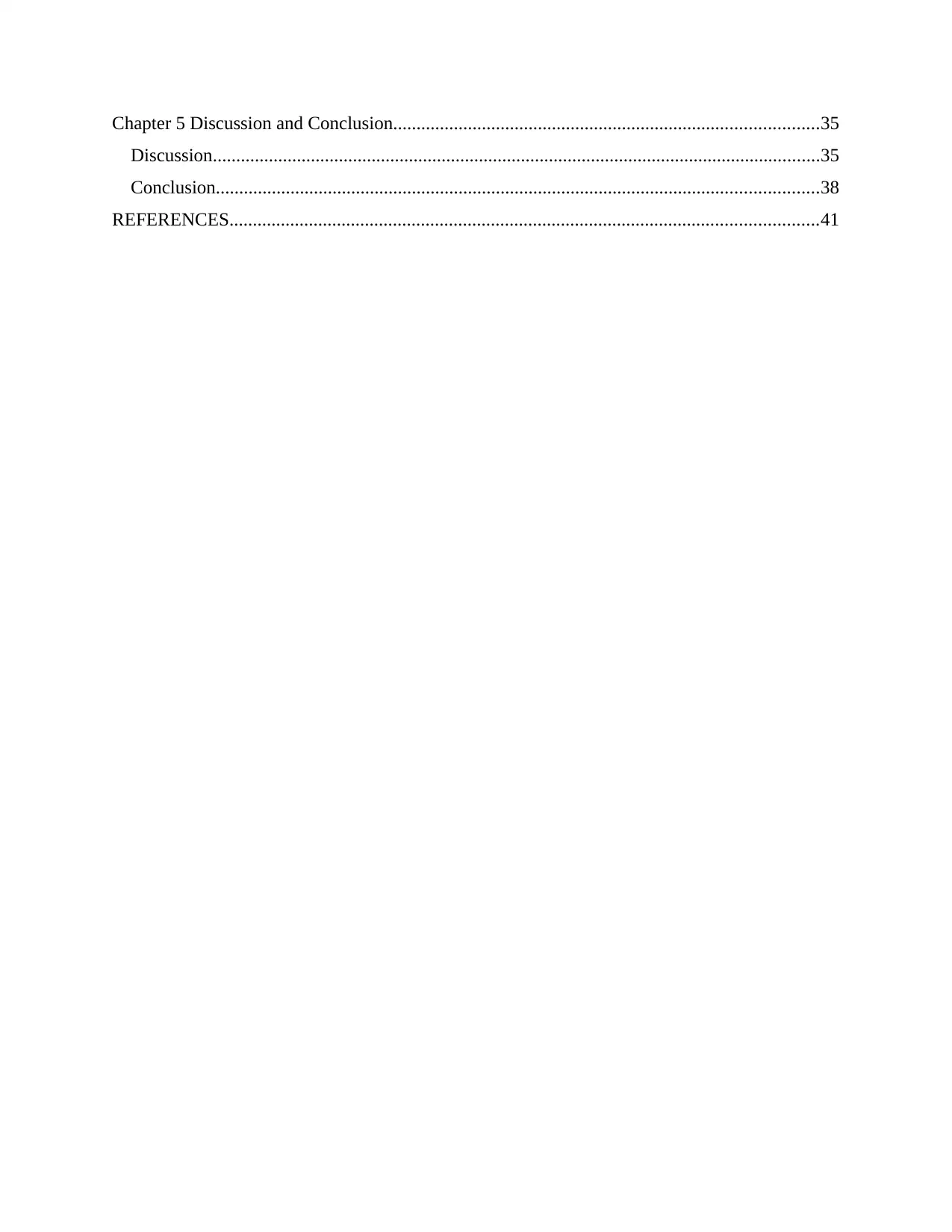
Chapter 5 Discussion and Conclusion...........................................................................................35
Discussion..................................................................................................................................35
Conclusion.................................................................................................................................38
REFERENCES..............................................................................................................................41
Discussion..................................................................................................................................35
Conclusion.................................................................................................................................38
REFERENCES..............................................................................................................................41
⊘ This is a preview!⊘
Do you want full access?
Subscribe today to unlock all pages.

Trusted by 1+ million students worldwide
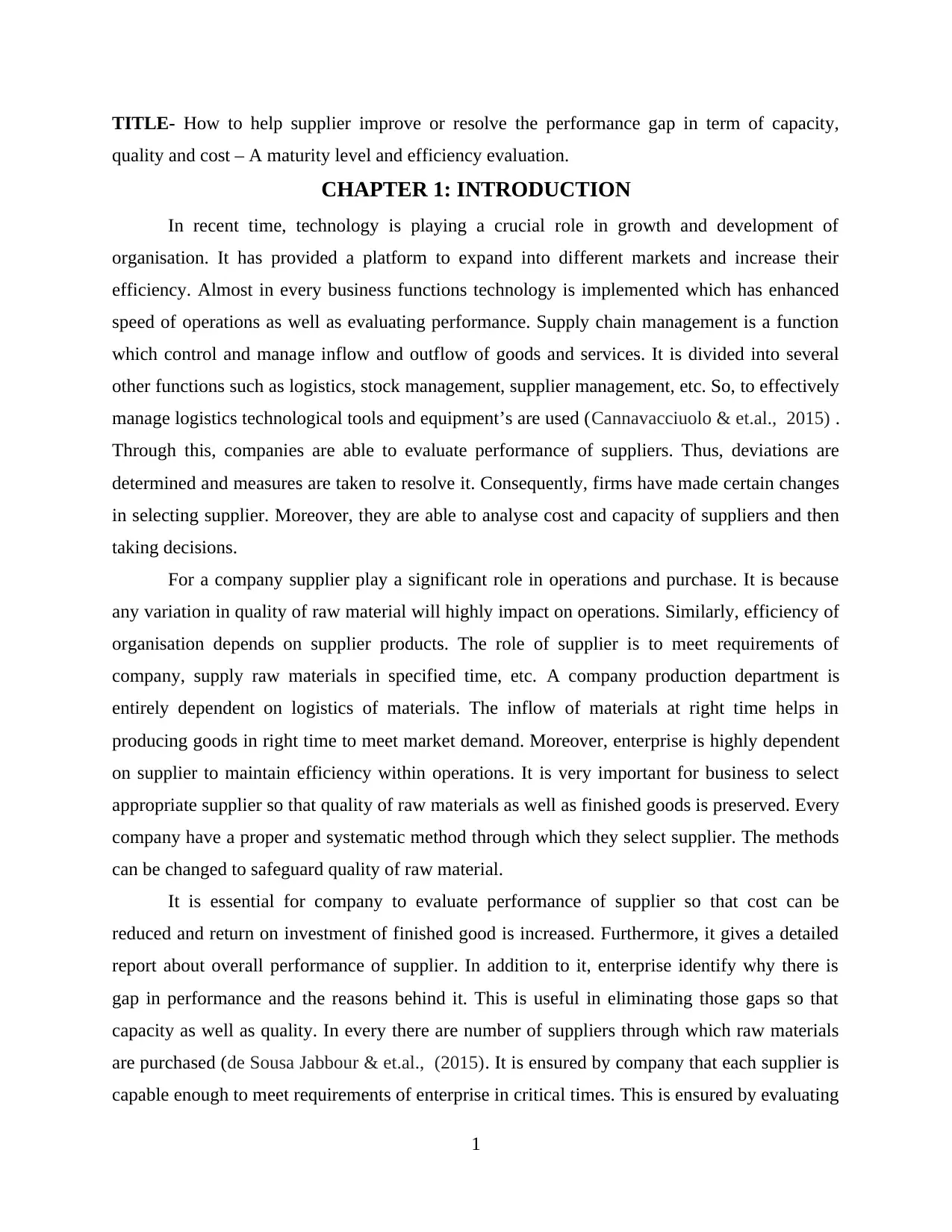
TITLE- How to help supplier improve or resolve the performance gap in term of capacity,
quality and cost – A maturity level and efficiency evaluation.
CHAPTER 1: INTRODUCTION
In recent time, technology is playing a crucial role in growth and development of
organisation. It has provided a platform to expand into different markets and increase their
efficiency. Almost in every business functions technology is implemented which has enhanced
speed of operations as well as evaluating performance. Supply chain management is a function
which control and manage inflow and outflow of goods and services. It is divided into several
other functions such as logistics, stock management, supplier management, etc. So, to effectively
manage logistics technological tools and equipment’s are used (Cannavacciuolo & et.al., 2015) .
Through this, companies are able to evaluate performance of suppliers. Thus, deviations are
determined and measures are taken to resolve it. Consequently, firms have made certain changes
in selecting supplier. Moreover, they are able to analyse cost and capacity of suppliers and then
taking decisions.
For a company supplier play a significant role in operations and purchase. It is because
any variation in quality of raw material will highly impact on operations. Similarly, efficiency of
organisation depends on supplier products. The role of supplier is to meet requirements of
company, supply raw materials in specified time, etc. A company production department is
entirely dependent on logistics of materials. The inflow of materials at right time helps in
producing goods in right time to meet market demand. Moreover, enterprise is highly dependent
on supplier to maintain efficiency within operations. It is very important for business to select
appropriate supplier so that quality of raw materials as well as finished goods is preserved. Every
company have a proper and systematic method through which they select supplier. The methods
can be changed to safeguard quality of raw material.
It is essential for company to evaluate performance of supplier so that cost can be
reduced and return on investment of finished good is increased. Furthermore, it gives a detailed
report about overall performance of supplier. In addition to it, enterprise identify why there is
gap in performance and the reasons behind it. This is useful in eliminating those gaps so that
capacity as well as quality. In every there are number of suppliers through which raw materials
are purchased (de Sousa Jabbour & et.al., (2015). It is ensured by company that each supplier is
capable enough to meet requirements of enterprise in critical times. This is ensured by evaluating
1
quality and cost – A maturity level and efficiency evaluation.
CHAPTER 1: INTRODUCTION
In recent time, technology is playing a crucial role in growth and development of
organisation. It has provided a platform to expand into different markets and increase their
efficiency. Almost in every business functions technology is implemented which has enhanced
speed of operations as well as evaluating performance. Supply chain management is a function
which control and manage inflow and outflow of goods and services. It is divided into several
other functions such as logistics, stock management, supplier management, etc. So, to effectively
manage logistics technological tools and equipment’s are used (Cannavacciuolo & et.al., 2015) .
Through this, companies are able to evaluate performance of suppliers. Thus, deviations are
determined and measures are taken to resolve it. Consequently, firms have made certain changes
in selecting supplier. Moreover, they are able to analyse cost and capacity of suppliers and then
taking decisions.
For a company supplier play a significant role in operations and purchase. It is because
any variation in quality of raw material will highly impact on operations. Similarly, efficiency of
organisation depends on supplier products. The role of supplier is to meet requirements of
company, supply raw materials in specified time, etc. A company production department is
entirely dependent on logistics of materials. The inflow of materials at right time helps in
producing goods in right time to meet market demand. Moreover, enterprise is highly dependent
on supplier to maintain efficiency within operations. It is very important for business to select
appropriate supplier so that quality of raw materials as well as finished goods is preserved. Every
company have a proper and systematic method through which they select supplier. The methods
can be changed to safeguard quality of raw material.
It is essential for company to evaluate performance of supplier so that cost can be
reduced and return on investment of finished good is increased. Furthermore, it gives a detailed
report about overall performance of supplier. In addition to it, enterprise identify why there is
gap in performance and the reasons behind it. This is useful in eliminating those gaps so that
capacity as well as quality. In every there are number of suppliers through which raw materials
are purchased (de Sousa Jabbour & et.al., (2015). It is ensured by company that each supplier is
capable enough to meet requirements of enterprise in critical times. This is ensured by evaluating
1
Paraphrase This Document
Need a fresh take? Get an instant paraphrase of this document with our AI Paraphraser
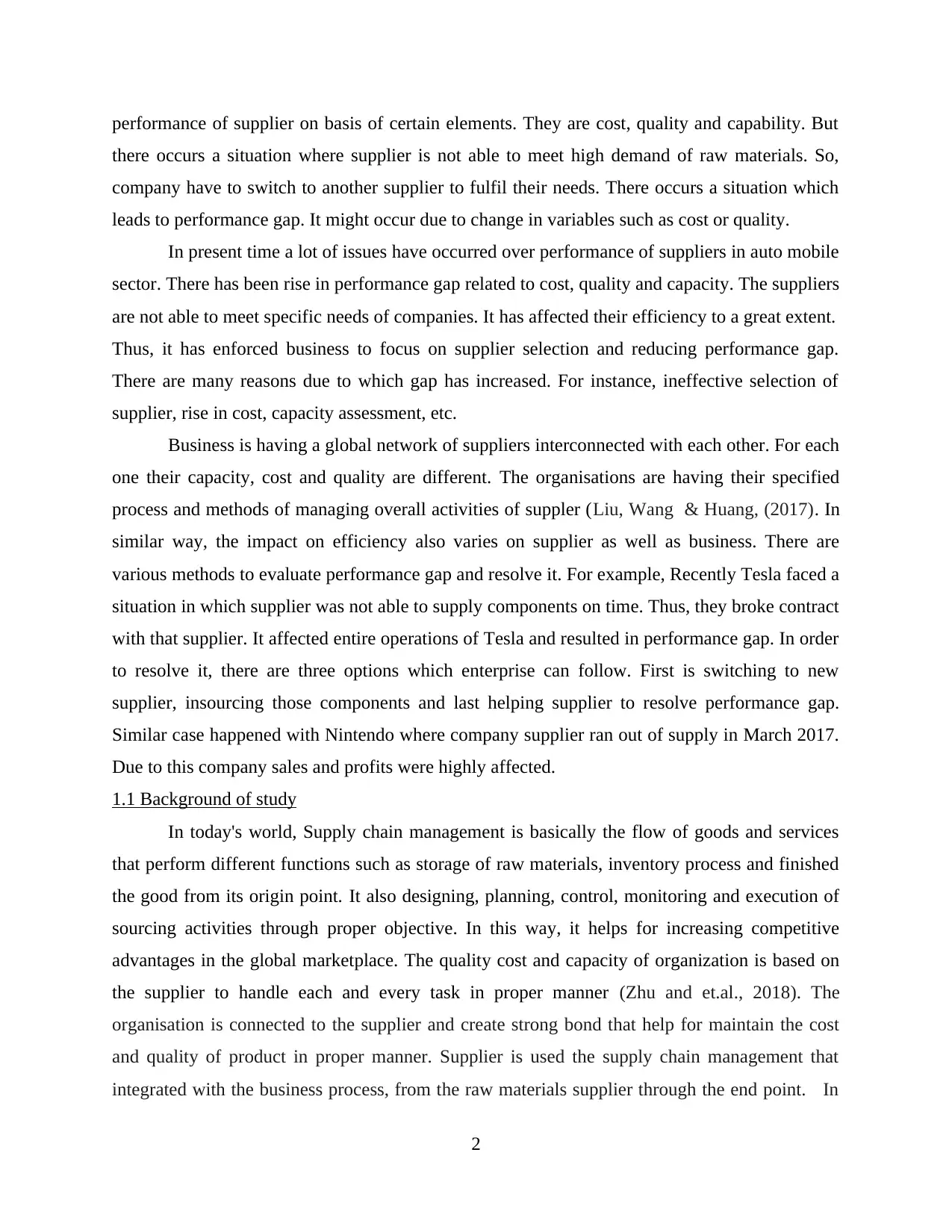
performance of supplier on basis of certain elements. They are cost, quality and capability. But
there occurs a situation where supplier is not able to meet high demand of raw materials. So,
company have to switch to another supplier to fulfil their needs. There occurs a situation which
leads to performance gap. It might occur due to change in variables such as cost or quality.
In present time a lot of issues have occurred over performance of suppliers in auto mobile
sector. There has been rise in performance gap related to cost, quality and capacity. The suppliers
are not able to meet specific needs of companies. It has affected their efficiency to a great extent.
Thus, it has enforced business to focus on supplier selection and reducing performance gap.
There are many reasons due to which gap has increased. For instance, ineffective selection of
supplier, rise in cost, capacity assessment, etc.
Business is having a global network of suppliers interconnected with each other. For each
one their capacity, cost and quality are different. The organisations are having their specified
process and methods of managing overall activities of suppler (Liu, Wang & Huang, (2017). In
similar way, the impact on efficiency also varies on supplier as well as business. There are
various methods to evaluate performance gap and resolve it. For example, Recently Tesla faced a
situation in which supplier was not able to supply components on time. Thus, they broke contract
with that supplier. It affected entire operations of Tesla and resulted in performance gap. In order
to resolve it, there are three options which enterprise can follow. First is switching to new
supplier, insourcing those components and last helping supplier to resolve performance gap.
Similar case happened with Nintendo where company supplier ran out of supply in March 2017.
Due to this company sales and profits were highly affected.
1.1 Background of study
In today's world, Supply chain management is basically the flow of goods and services
that perform different functions such as storage of raw materials, inventory process and finished
the good from its origin point. It also designing, planning, control, monitoring and execution of
sourcing activities through proper objective. In this way, it helps for increasing competitive
advantages in the global marketplace. The quality cost and capacity of organization is based on
the supplier to handle each and every task in proper manner (Zhu and et.al., 2018). The
organisation is connected to the supplier and create strong bond that help for maintain the cost
and quality of product in proper manner. Supplier is used the supply chain management that
integrated with the business process, from the raw materials supplier through the end point. In
2
there occurs a situation where supplier is not able to meet high demand of raw materials. So,
company have to switch to another supplier to fulfil their needs. There occurs a situation which
leads to performance gap. It might occur due to change in variables such as cost or quality.
In present time a lot of issues have occurred over performance of suppliers in auto mobile
sector. There has been rise in performance gap related to cost, quality and capacity. The suppliers
are not able to meet specific needs of companies. It has affected their efficiency to a great extent.
Thus, it has enforced business to focus on supplier selection and reducing performance gap.
There are many reasons due to which gap has increased. For instance, ineffective selection of
supplier, rise in cost, capacity assessment, etc.
Business is having a global network of suppliers interconnected with each other. For each
one their capacity, cost and quality are different. The organisations are having their specified
process and methods of managing overall activities of suppler (Liu, Wang & Huang, (2017). In
similar way, the impact on efficiency also varies on supplier as well as business. There are
various methods to evaluate performance gap and resolve it. For example, Recently Tesla faced a
situation in which supplier was not able to supply components on time. Thus, they broke contract
with that supplier. It affected entire operations of Tesla and resulted in performance gap. In order
to resolve it, there are three options which enterprise can follow. First is switching to new
supplier, insourcing those components and last helping supplier to resolve performance gap.
Similar case happened with Nintendo where company supplier ran out of supply in March 2017.
Due to this company sales and profits were highly affected.
1.1 Background of study
In today's world, Supply chain management is basically the flow of goods and services
that perform different functions such as storage of raw materials, inventory process and finished
the good from its origin point. It also designing, planning, control, monitoring and execution of
sourcing activities through proper objective. In this way, it helps for increasing competitive
advantages in the global marketplace. The quality cost and capacity of organization is based on
the supplier to handle each and every task in proper manner (Zhu and et.al., 2018). The
organisation is connected to the supplier and create strong bond that help for maintain the cost
and quality of product in proper manner. Supplier is used the supply chain management that
integrated with the business process, from the raw materials supplier through the end point. In
2
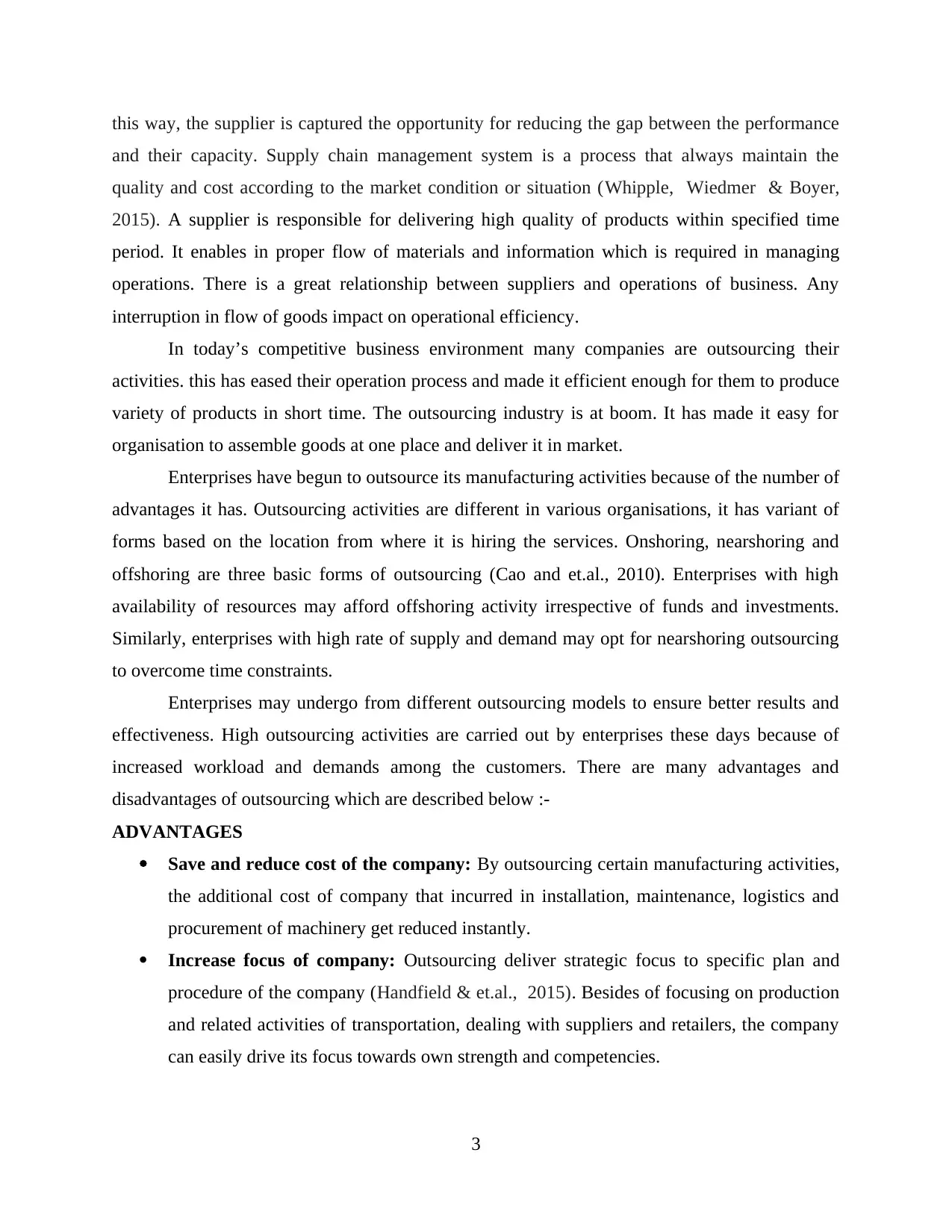
this way, the supplier is captured the opportunity for reducing the gap between the performance
and their capacity. Supply chain management system is a process that always maintain the
quality and cost according to the market condition or situation (Whipple, Wiedmer & Boyer,
2015). A supplier is responsible for delivering high quality of products within specified time
period. It enables in proper flow of materials and information which is required in managing
operations. There is a great relationship between suppliers and operations of business. Any
interruption in flow of goods impact on operational efficiency.
In today’s competitive business environment many companies are outsourcing their
activities. this has eased their operation process and made it efficient enough for them to produce
variety of products in short time. The outsourcing industry is at boom. It has made it easy for
organisation to assemble goods at one place and deliver it in market.
Enterprises have begun to outsource its manufacturing activities because of the number of
advantages it has. Outsourcing activities are different in various organisations, it has variant of
forms based on the location from where it is hiring the services. Onshoring, nearshoring and
offshoring are three basic forms of outsourcing (Cao and et.al., 2010). Enterprises with high
availability of resources may afford offshoring activity irrespective of funds and investments.
Similarly, enterprises with high rate of supply and demand may opt for nearshoring outsourcing
to overcome time constraints.
Enterprises may undergo from different outsourcing models to ensure better results and
effectiveness. High outsourcing activities are carried out by enterprises these days because of
increased workload and demands among the customers. There are many advantages and
disadvantages of outsourcing which are described below :-
ADVANTAGES
Save and reduce cost of the company: By outsourcing certain manufacturing activities,
the additional cost of company that incurred in installation, maintenance, logistics and
procurement of machinery get reduced instantly.
Increase focus of company: Outsourcing deliver strategic focus to specific plan and
procedure of the company (Handfield & et.al., 2015). Besides of focusing on production
and related activities of transportation, dealing with suppliers and retailers, the company
can easily drive its focus towards own strength and competencies.
3
and their capacity. Supply chain management system is a process that always maintain the
quality and cost according to the market condition or situation (Whipple, Wiedmer & Boyer,
2015). A supplier is responsible for delivering high quality of products within specified time
period. It enables in proper flow of materials and information which is required in managing
operations. There is a great relationship between suppliers and operations of business. Any
interruption in flow of goods impact on operational efficiency.
In today’s competitive business environment many companies are outsourcing their
activities. this has eased their operation process and made it efficient enough for them to produce
variety of products in short time. The outsourcing industry is at boom. It has made it easy for
organisation to assemble goods at one place and deliver it in market.
Enterprises have begun to outsource its manufacturing activities because of the number of
advantages it has. Outsourcing activities are different in various organisations, it has variant of
forms based on the location from where it is hiring the services. Onshoring, nearshoring and
offshoring are three basic forms of outsourcing (Cao and et.al., 2010). Enterprises with high
availability of resources may afford offshoring activity irrespective of funds and investments.
Similarly, enterprises with high rate of supply and demand may opt for nearshoring outsourcing
to overcome time constraints.
Enterprises may undergo from different outsourcing models to ensure better results and
effectiveness. High outsourcing activities are carried out by enterprises these days because of
increased workload and demands among the customers. There are many advantages and
disadvantages of outsourcing which are described below :-
ADVANTAGES
Save and reduce cost of the company: By outsourcing certain manufacturing activities,
the additional cost of company that incurred in installation, maintenance, logistics and
procurement of machinery get reduced instantly.
Increase focus of company: Outsourcing deliver strategic focus to specific plan and
procedure of the company (Handfield & et.al., 2015). Besides of focusing on production
and related activities of transportation, dealing with suppliers and retailers, the company
can easily drive its focus towards own strength and competencies.
3
⊘ This is a preview!⊘
Do you want full access?
Subscribe today to unlock all pages.

Trusted by 1+ million students worldwide
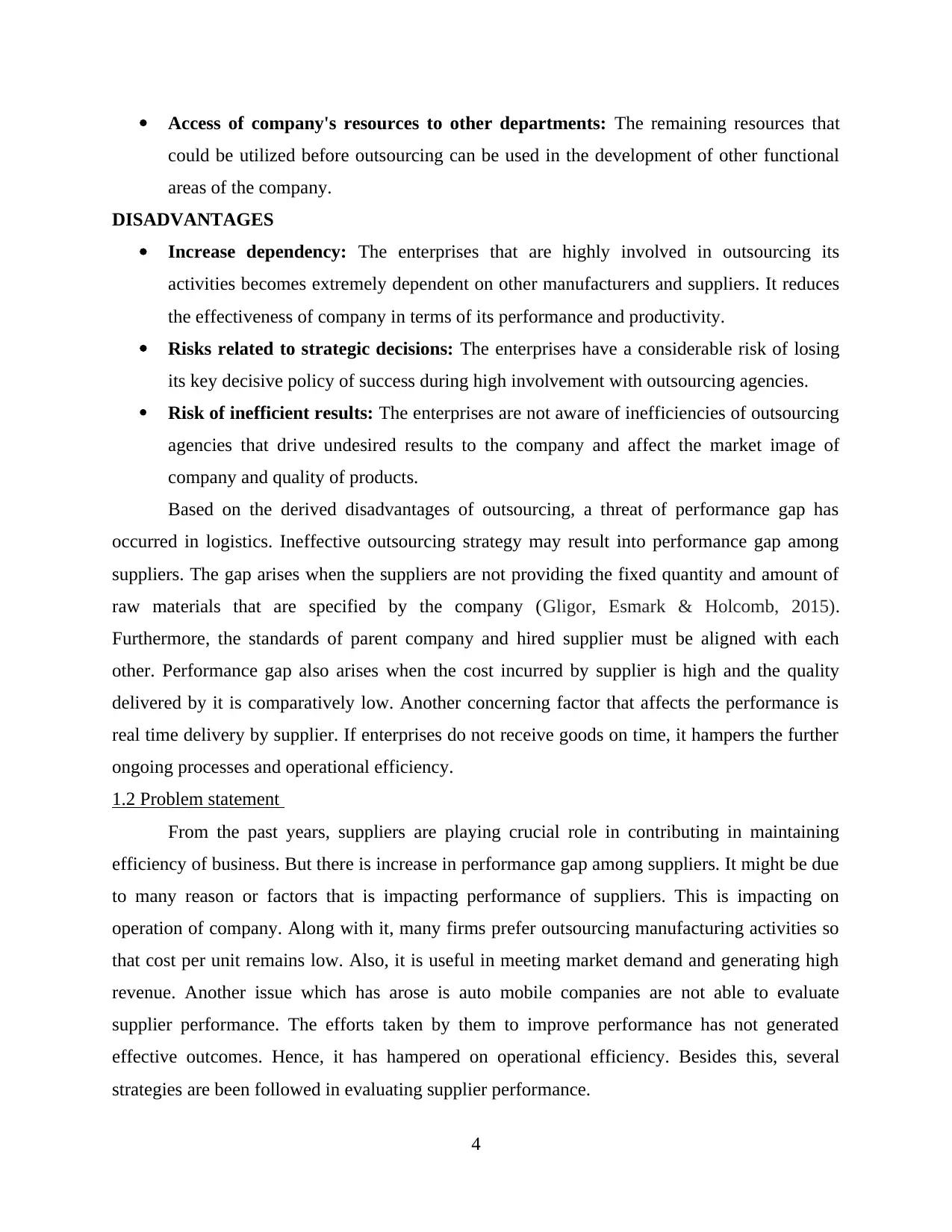
Access of company's resources to other departments: The remaining resources that
could be utilized before outsourcing can be used in the development of other functional
areas of the company.
DISADVANTAGES
Increase dependency: The enterprises that are highly involved in outsourcing its
activities becomes extremely dependent on other manufacturers and suppliers. It reduces
the effectiveness of company in terms of its performance and productivity.
Risks related to strategic decisions: The enterprises have a considerable risk of losing
its key decisive policy of success during high involvement with outsourcing agencies.
Risk of inefficient results: The enterprises are not aware of inefficiencies of outsourcing
agencies that drive undesired results to the company and affect the market image of
company and quality of products.
Based on the derived disadvantages of outsourcing, a threat of performance gap has
occurred in logistics. Ineffective outsourcing strategy may result into performance gap among
suppliers. The gap arises when the suppliers are not providing the fixed quantity and amount of
raw materials that are specified by the company (Gligor, Esmark & Holcomb, 2015).
Furthermore, the standards of parent company and hired supplier must be aligned with each
other. Performance gap also arises when the cost incurred by supplier is high and the quality
delivered by it is comparatively low. Another concerning factor that affects the performance is
real time delivery by supplier. If enterprises do not receive goods on time, it hampers the further
ongoing processes and operational efficiency.
1.2 Problem statement
From the past years, suppliers are playing crucial role in contributing in maintaining
efficiency of business. But there is increase in performance gap among suppliers. It might be due
to many reason or factors that is impacting performance of suppliers. This is impacting on
operation of company. Along with it, many firms prefer outsourcing manufacturing activities so
that cost per unit remains low. Also, it is useful in meeting market demand and generating high
revenue. Another issue which has arose is auto mobile companies are not able to evaluate
supplier performance. The efforts taken by them to improve performance has not generated
effective outcomes. Hence, it has hampered on operational efficiency. Besides this, several
strategies are been followed in evaluating supplier performance.
4
could be utilized before outsourcing can be used in the development of other functional
areas of the company.
DISADVANTAGES
Increase dependency: The enterprises that are highly involved in outsourcing its
activities becomes extremely dependent on other manufacturers and suppliers. It reduces
the effectiveness of company in terms of its performance and productivity.
Risks related to strategic decisions: The enterprises have a considerable risk of losing
its key decisive policy of success during high involvement with outsourcing agencies.
Risk of inefficient results: The enterprises are not aware of inefficiencies of outsourcing
agencies that drive undesired results to the company and affect the market image of
company and quality of products.
Based on the derived disadvantages of outsourcing, a threat of performance gap has
occurred in logistics. Ineffective outsourcing strategy may result into performance gap among
suppliers. The gap arises when the suppliers are not providing the fixed quantity and amount of
raw materials that are specified by the company (Gligor, Esmark & Holcomb, 2015).
Furthermore, the standards of parent company and hired supplier must be aligned with each
other. Performance gap also arises when the cost incurred by supplier is high and the quality
delivered by it is comparatively low. Another concerning factor that affects the performance is
real time delivery by supplier. If enterprises do not receive goods on time, it hampers the further
ongoing processes and operational efficiency.
1.2 Problem statement
From the past years, suppliers are playing crucial role in contributing in maintaining
efficiency of business. But there is increase in performance gap among suppliers. It might be due
to many reason or factors that is impacting performance of suppliers. This is impacting on
operation of company. Along with it, many firms prefer outsourcing manufacturing activities so
that cost per unit remains low. Also, it is useful in meeting market demand and generating high
revenue. Another issue which has arose is auto mobile companies are not able to evaluate
supplier performance. The efforts taken by them to improve performance has not generated
effective outcomes. Hence, it has hampered on operational efficiency. Besides this, several
strategies are been followed in evaluating supplier performance.
4
Paraphrase This Document
Need a fresh take? Get an instant paraphrase of this document with our AI Paraphraser
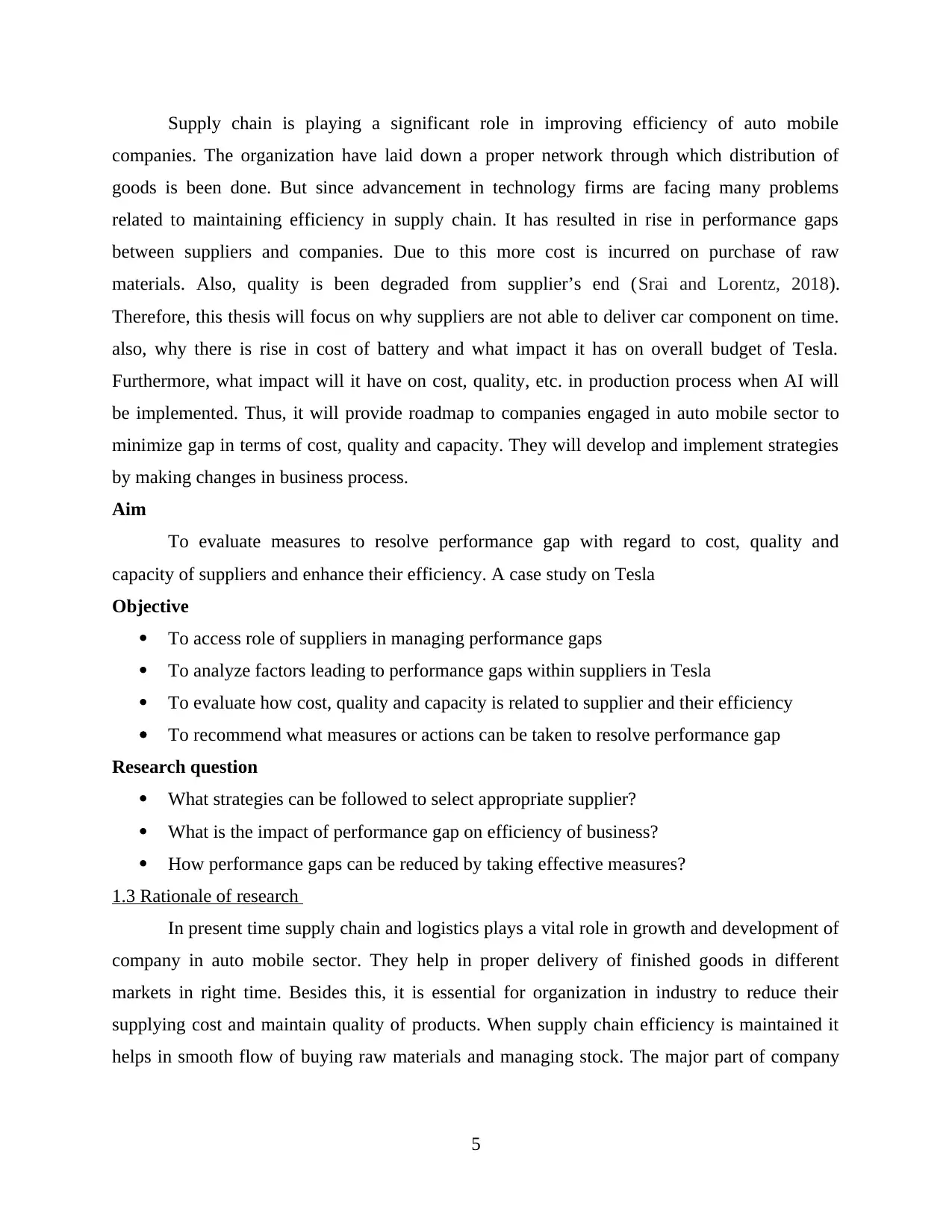
Supply chain is playing a significant role in improving efficiency of auto mobile
companies. The organization have laid down a proper network through which distribution of
goods is been done. But since advancement in technology firms are facing many problems
related to maintaining efficiency in supply chain. It has resulted in rise in performance gaps
between suppliers and companies. Due to this more cost is incurred on purchase of raw
materials. Also, quality is been degraded from supplier’s end (Srai and Lorentz, 2018).
Therefore, this thesis will focus on why suppliers are not able to deliver car component on time.
also, why there is rise in cost of battery and what impact it has on overall budget of Tesla.
Furthermore, what impact will it have on cost, quality, etc. in production process when AI will
be implemented. Thus, it will provide roadmap to companies engaged in auto mobile sector to
minimize gap in terms of cost, quality and capacity. They will develop and implement strategies
by making changes in business process.
Aim
To evaluate measures to resolve performance gap with regard to cost, quality and
capacity of suppliers and enhance their efficiency. A case study on Tesla
Objective
To access role of suppliers in managing performance gaps
To analyze factors leading to performance gaps within suppliers in Tesla
To evaluate how cost, quality and capacity is related to supplier and their efficiency
To recommend what measures or actions can be taken to resolve performance gap
Research question
What strategies can be followed to select appropriate supplier?
What is the impact of performance gap on efficiency of business?
How performance gaps can be reduced by taking effective measures?
1.3 Rationale of research
In present time supply chain and logistics plays a vital role in growth and development of
company in auto mobile sector. They help in proper delivery of finished goods in different
markets in right time. Besides this, it is essential for organization in industry to reduce their
supplying cost and maintain quality of products. When supply chain efficiency is maintained it
helps in smooth flow of buying raw materials and managing stock. The major part of company
5
companies. The organization have laid down a proper network through which distribution of
goods is been done. But since advancement in technology firms are facing many problems
related to maintaining efficiency in supply chain. It has resulted in rise in performance gaps
between suppliers and companies. Due to this more cost is incurred on purchase of raw
materials. Also, quality is been degraded from supplier’s end (Srai and Lorentz, 2018).
Therefore, this thesis will focus on why suppliers are not able to deliver car component on time.
also, why there is rise in cost of battery and what impact it has on overall budget of Tesla.
Furthermore, what impact will it have on cost, quality, etc. in production process when AI will
be implemented. Thus, it will provide roadmap to companies engaged in auto mobile sector to
minimize gap in terms of cost, quality and capacity. They will develop and implement strategies
by making changes in business process.
Aim
To evaluate measures to resolve performance gap with regard to cost, quality and
capacity of suppliers and enhance their efficiency. A case study on Tesla
Objective
To access role of suppliers in managing performance gaps
To analyze factors leading to performance gaps within suppliers in Tesla
To evaluate how cost, quality and capacity is related to supplier and their efficiency
To recommend what measures or actions can be taken to resolve performance gap
Research question
What strategies can be followed to select appropriate supplier?
What is the impact of performance gap on efficiency of business?
How performance gaps can be reduced by taking effective measures?
1.3 Rationale of research
In present time supply chain and logistics plays a vital role in growth and development of
company in auto mobile sector. They help in proper delivery of finished goods in different
markets in right time. Besides this, it is essential for organization in industry to reduce their
supplying cost and maintain quality of products. When supply chain efficiency is maintained it
helps in smooth flow of buying raw materials and managing stock. The major part of company
5
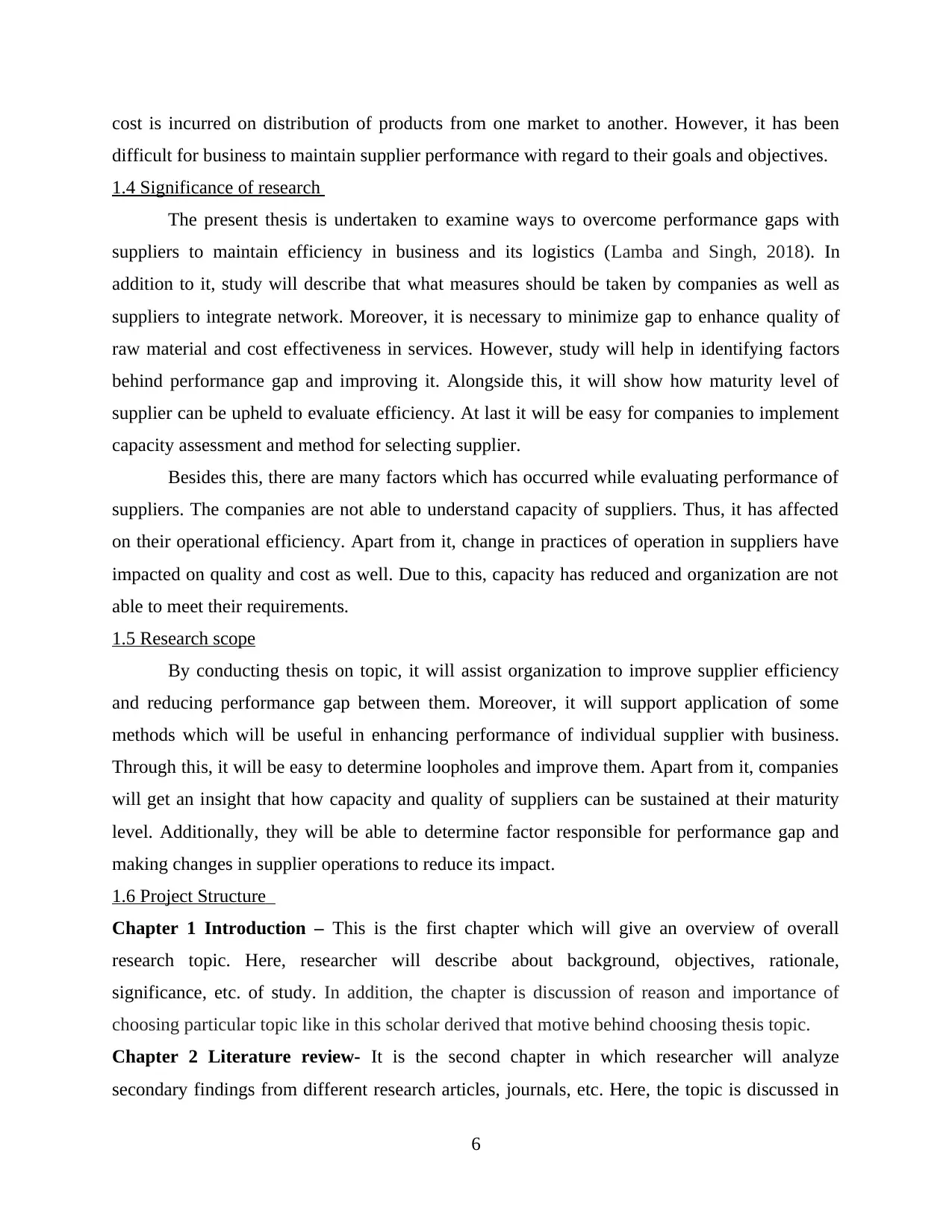
cost is incurred on distribution of products from one market to another. However, it has been
difficult for business to maintain supplier performance with regard to their goals and objectives.
1.4 Significance of research
The present thesis is undertaken to examine ways to overcome performance gaps with
suppliers to maintain efficiency in business and its logistics (Lamba and Singh, 2018). In
addition to it, study will describe that what measures should be taken by companies as well as
suppliers to integrate network. Moreover, it is necessary to minimize gap to enhance quality of
raw material and cost effectiveness in services. However, study will help in identifying factors
behind performance gap and improving it. Alongside this, it will show how maturity level of
supplier can be upheld to evaluate efficiency. At last it will be easy for companies to implement
capacity assessment and method for selecting supplier.
Besides this, there are many factors which has occurred while evaluating performance of
suppliers. The companies are not able to understand capacity of suppliers. Thus, it has affected
on their operational efficiency. Apart from it, change in practices of operation in suppliers have
impacted on quality and cost as well. Due to this, capacity has reduced and organization are not
able to meet their requirements.
1.5 Research scope
By conducting thesis on topic, it will assist organization to improve supplier efficiency
and reducing performance gap between them. Moreover, it will support application of some
methods which will be useful in enhancing performance of individual supplier with business.
Through this, it will be easy to determine loopholes and improve them. Apart from it, companies
will get an insight that how capacity and quality of suppliers can be sustained at their maturity
level. Additionally, they will be able to determine factor responsible for performance gap and
making changes in supplier operations to reduce its impact.
1.6 Project Structure
Chapter 1 Introduction – This is the first chapter which will give an overview of overall
research topic. Here, researcher will describe about background, objectives, rationale,
significance, etc. of study. In addition, the chapter is discussion of reason and importance of
choosing particular topic like in this scholar derived that motive behind choosing thesis topic.
Chapter 2 Literature review- It is the second chapter in which researcher will analyze
secondary findings from different research articles, journals, etc. Here, the topic is discussed in
6
difficult for business to maintain supplier performance with regard to their goals and objectives.
1.4 Significance of research
The present thesis is undertaken to examine ways to overcome performance gaps with
suppliers to maintain efficiency in business and its logistics (Lamba and Singh, 2018). In
addition to it, study will describe that what measures should be taken by companies as well as
suppliers to integrate network. Moreover, it is necessary to minimize gap to enhance quality of
raw material and cost effectiveness in services. However, study will help in identifying factors
behind performance gap and improving it. Alongside this, it will show how maturity level of
supplier can be upheld to evaluate efficiency. At last it will be easy for companies to implement
capacity assessment and method for selecting supplier.
Besides this, there are many factors which has occurred while evaluating performance of
suppliers. The companies are not able to understand capacity of suppliers. Thus, it has affected
on their operational efficiency. Apart from it, change in practices of operation in suppliers have
impacted on quality and cost as well. Due to this, capacity has reduced and organization are not
able to meet their requirements.
1.5 Research scope
By conducting thesis on topic, it will assist organization to improve supplier efficiency
and reducing performance gap between them. Moreover, it will support application of some
methods which will be useful in enhancing performance of individual supplier with business.
Through this, it will be easy to determine loopholes and improve them. Apart from it, companies
will get an insight that how capacity and quality of suppliers can be sustained at their maturity
level. Additionally, they will be able to determine factor responsible for performance gap and
making changes in supplier operations to reduce its impact.
1.6 Project Structure
Chapter 1 Introduction – This is the first chapter which will give an overview of overall
research topic. Here, researcher will describe about background, objectives, rationale,
significance, etc. of study. In addition, the chapter is discussion of reason and importance of
choosing particular topic like in this scholar derived that motive behind choosing thesis topic.
Chapter 2 Literature review- It is the second chapter in which researcher will analyze
secondary findings from different research articles, journals, etc. Here, the topic is discussed in
6
⊘ This is a preview!⊘
Do you want full access?
Subscribe today to unlock all pages.

Trusted by 1+ million students worldwide
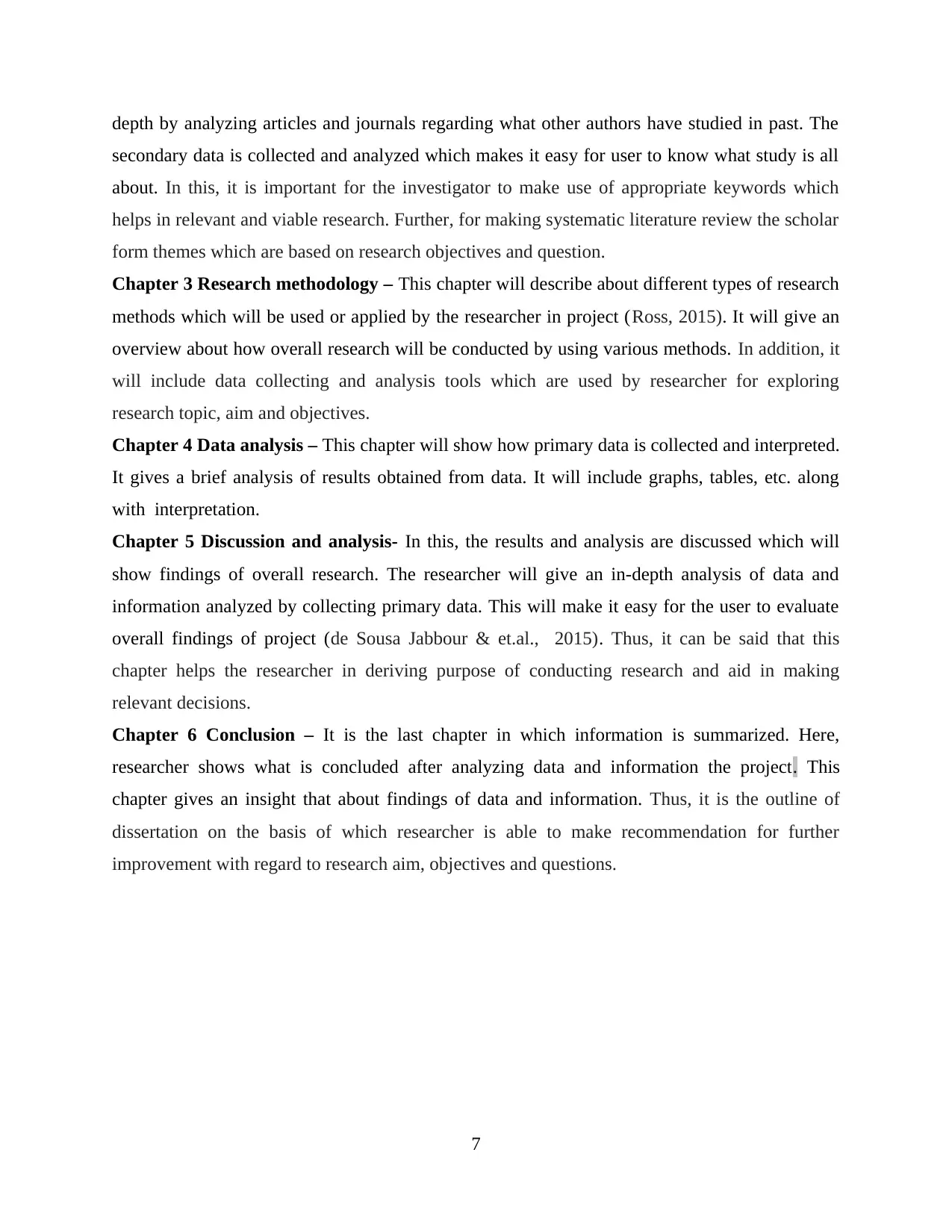
depth by analyzing articles and journals regarding what other authors have studied in past. The
secondary data is collected and analyzed which makes it easy for user to know what study is all
about. In this, it is important for the investigator to make use of appropriate keywords which
helps in relevant and viable research. Further, for making systematic literature review the scholar
form themes which are based on research objectives and question.
Chapter 3 Research methodology – This chapter will describe about different types of research
methods which will be used or applied by the researcher in project (Ross, 2015). It will give an
overview about how overall research will be conducted by using various methods. In addition, it
will include data collecting and analysis tools which are used by researcher for exploring
research topic, aim and objectives.
Chapter 4 Data analysis – This chapter will show how primary data is collected and interpreted.
It gives a brief analysis of results obtained from data. It will include graphs, tables, etc. along
with interpretation.
Chapter 5 Discussion and analysis- In this, the results and analysis are discussed which will
show findings of overall research. The researcher will give an in-depth analysis of data and
information analyzed by collecting primary data. This will make it easy for the user to evaluate
overall findings of project (de Sousa Jabbour & et.al., 2015). Thus, it can be said that this
chapter helps the researcher in deriving purpose of conducting research and aid in making
relevant decisions.
Chapter 6 Conclusion – It is the last chapter in which information is summarized. Here,
researcher shows what is concluded after analyzing data and information the project. This
chapter gives an insight that about findings of data and information. Thus, it is the outline of
dissertation on the basis of which researcher is able to make recommendation for further
improvement with regard to research aim, objectives and questions.
7
secondary data is collected and analyzed which makes it easy for user to know what study is all
about. In this, it is important for the investigator to make use of appropriate keywords which
helps in relevant and viable research. Further, for making systematic literature review the scholar
form themes which are based on research objectives and question.
Chapter 3 Research methodology – This chapter will describe about different types of research
methods which will be used or applied by the researcher in project (Ross, 2015). It will give an
overview about how overall research will be conducted by using various methods. In addition, it
will include data collecting and analysis tools which are used by researcher for exploring
research topic, aim and objectives.
Chapter 4 Data analysis – This chapter will show how primary data is collected and interpreted.
It gives a brief analysis of results obtained from data. It will include graphs, tables, etc. along
with interpretation.
Chapter 5 Discussion and analysis- In this, the results and analysis are discussed which will
show findings of overall research. The researcher will give an in-depth analysis of data and
information analyzed by collecting primary data. This will make it easy for the user to evaluate
overall findings of project (de Sousa Jabbour & et.al., 2015). Thus, it can be said that this
chapter helps the researcher in deriving purpose of conducting research and aid in making
relevant decisions.
Chapter 6 Conclusion – It is the last chapter in which information is summarized. Here,
researcher shows what is concluded after analyzing data and information the project. This
chapter gives an insight that about findings of data and information. Thus, it is the outline of
dissertation on the basis of which researcher is able to make recommendation for further
improvement with regard to research aim, objectives and questions.
7
Paraphrase This Document
Need a fresh take? Get an instant paraphrase of this document with our AI Paraphraser
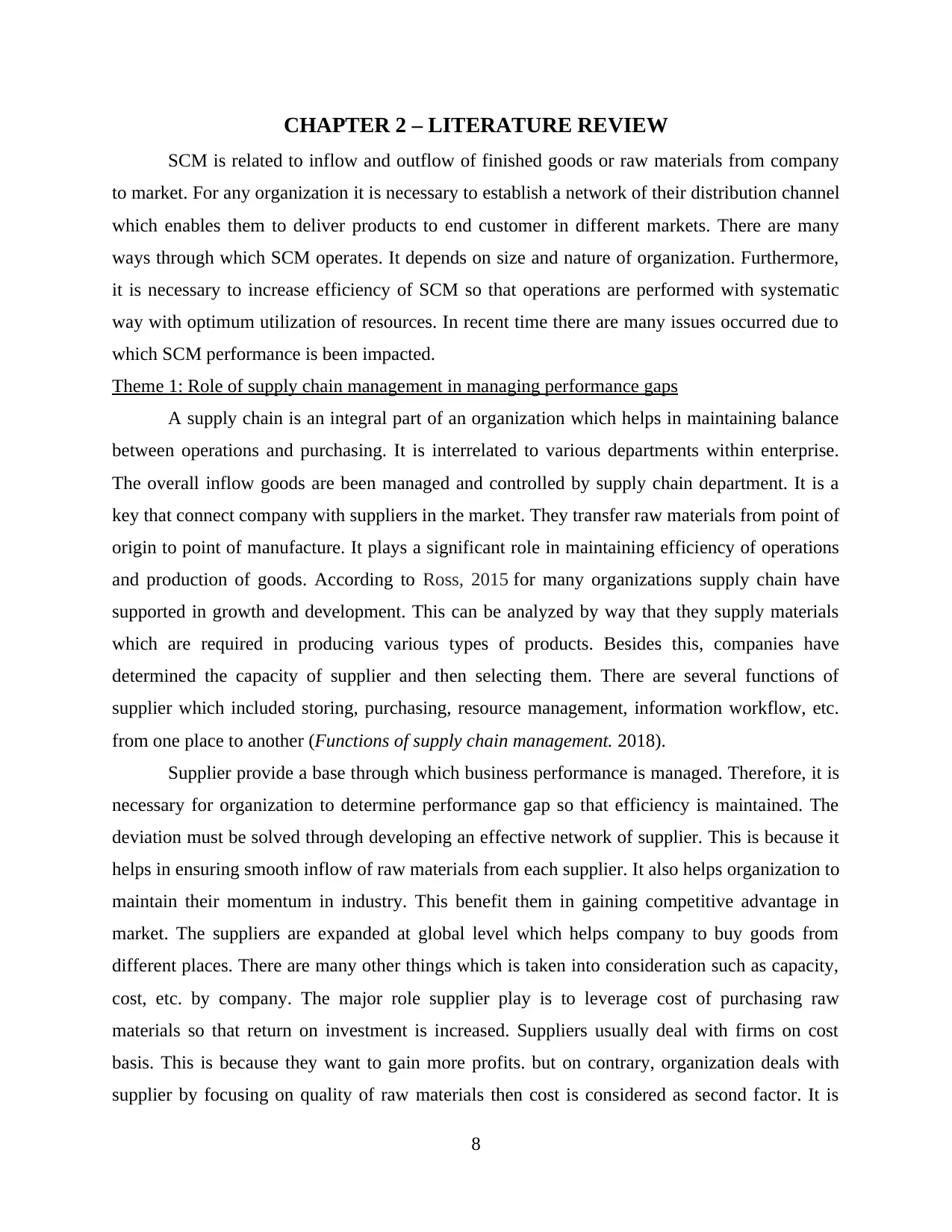
CHAPTER 2 – LITERATURE REVIEW
SCM is related to inflow and outflow of finished goods or raw materials from company
to market. For any organization it is necessary to establish a network of their distribution channel
which enables them to deliver products to end customer in different markets. There are many
ways through which SCM operates. It depends on size and nature of organization. Furthermore,
it is necessary to increase efficiency of SCM so that operations are performed with systematic
way with optimum utilization of resources. In recent time there are many issues occurred due to
which SCM performance is been impacted.
Theme 1: Role of supply chain management in managing performance gaps
A supply chain is an integral part of an organization which helps in maintaining balance
between operations and purchasing. It is interrelated to various departments within enterprise.
The overall inflow goods are been managed and controlled by supply chain department. It is a
key that connect company with suppliers in the market. They transfer raw materials from point of
origin to point of manufacture. It plays a significant role in maintaining efficiency of operations
and production of goods. According to Ross, 2015 for many organizations supply chain have
supported in growth and development. This can be analyzed by way that they supply materials
which are required in producing various types of products. Besides this, companies have
determined the capacity of supplier and then selecting them. There are several functions of
supplier which included storing, purchasing, resource management, information workflow, etc.
from one place to another (Functions of supply chain management. 2018).
Supplier provide a base through which business performance is managed. Therefore, it is
necessary for organization to determine performance gap so that efficiency is maintained. The
deviation must be solved through developing an effective network of supplier. This is because it
helps in ensuring smooth inflow of raw materials from each supplier. It also helps organization to
maintain their momentum in industry. This benefit them in gaining competitive advantage in
market. The suppliers are expanded at global level which helps company to buy goods from
different places. There are many other things which is taken into consideration such as capacity,
cost, etc. by company. The major role supplier play is to leverage cost of purchasing raw
materials so that return on investment is increased. Suppliers usually deal with firms on cost
basis. This is because they want to gain more profits. but on contrary, organization deals with
supplier by focusing on quality of raw materials then cost is considered as second factor. It is
8
SCM is related to inflow and outflow of finished goods or raw materials from company
to market. For any organization it is necessary to establish a network of their distribution channel
which enables them to deliver products to end customer in different markets. There are many
ways through which SCM operates. It depends on size and nature of organization. Furthermore,
it is necessary to increase efficiency of SCM so that operations are performed with systematic
way with optimum utilization of resources. In recent time there are many issues occurred due to
which SCM performance is been impacted.
Theme 1: Role of supply chain management in managing performance gaps
A supply chain is an integral part of an organization which helps in maintaining balance
between operations and purchasing. It is interrelated to various departments within enterprise.
The overall inflow goods are been managed and controlled by supply chain department. It is a
key that connect company with suppliers in the market. They transfer raw materials from point of
origin to point of manufacture. It plays a significant role in maintaining efficiency of operations
and production of goods. According to Ross, 2015 for many organizations supply chain have
supported in growth and development. This can be analyzed by way that they supply materials
which are required in producing various types of products. Besides this, companies have
determined the capacity of supplier and then selecting them. There are several functions of
supplier which included storing, purchasing, resource management, information workflow, etc.
from one place to another (Functions of supply chain management. 2018).
Supplier provide a base through which business performance is managed. Therefore, it is
necessary for organization to determine performance gap so that efficiency is maintained. The
deviation must be solved through developing an effective network of supplier. This is because it
helps in ensuring smooth inflow of raw materials from each supplier. It also helps organization to
maintain their momentum in industry. This benefit them in gaining competitive advantage in
market. The suppliers are expanded at global level which helps company to buy goods from
different places. There are many other things which is taken into consideration such as capacity,
cost, etc. by company. The major role supplier play is to leverage cost of purchasing raw
materials so that return on investment is increased. Suppliers usually deal with firms on cost
basis. This is because they want to gain more profits. but on contrary, organization deals with
supplier by focusing on quality of raw materials then cost is considered as second factor. It is
8
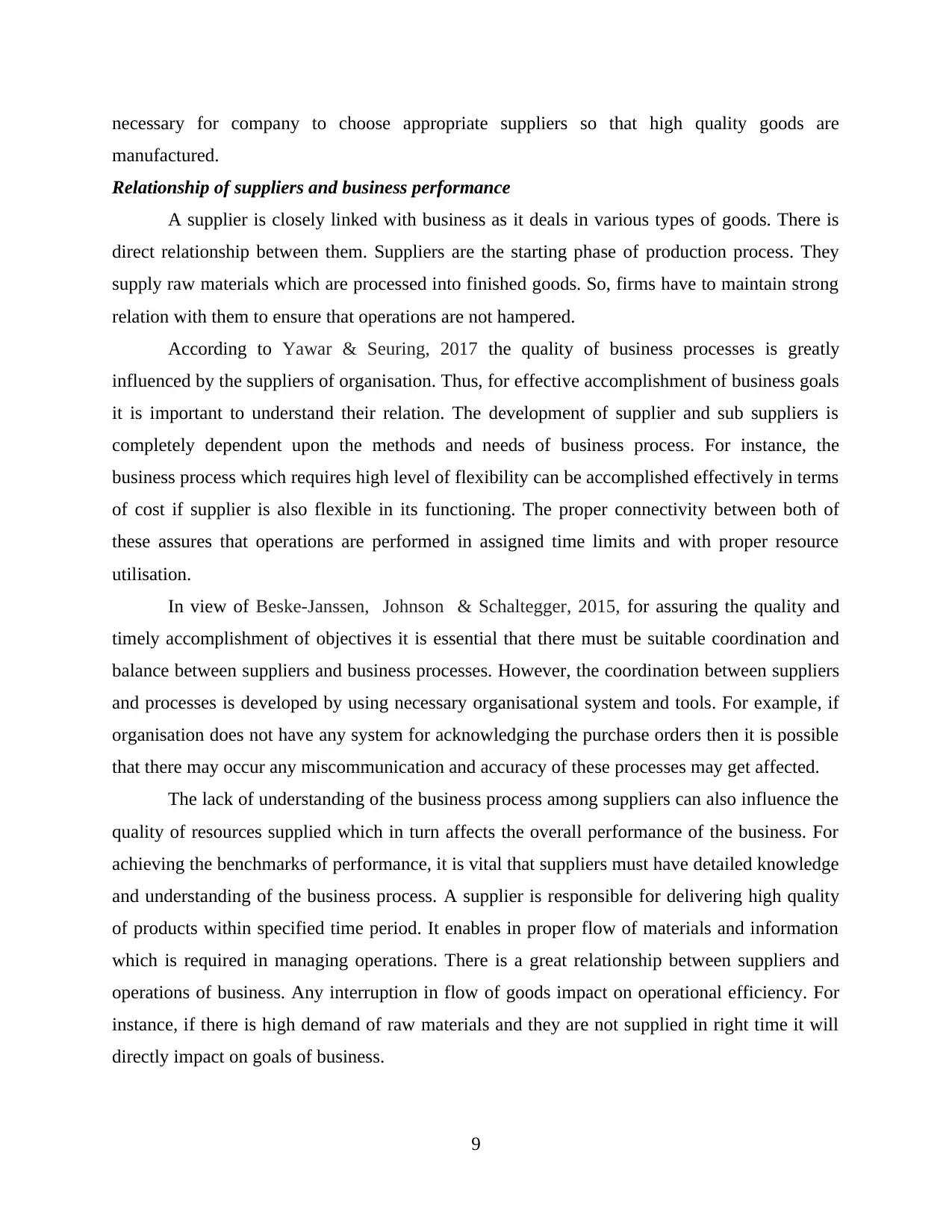
necessary for company to choose appropriate suppliers so that high quality goods are
manufactured.
Relationship of suppliers and business performance
A supplier is closely linked with business as it deals in various types of goods. There is
direct relationship between them. Suppliers are the starting phase of production process. They
supply raw materials which are processed into finished goods. So, firms have to maintain strong
relation with them to ensure that operations are not hampered.
According to Yawar & Seuring, 2017 the quality of business processes is greatly
influenced by the suppliers of organisation. Thus, for effective accomplishment of business goals
it is important to understand their relation. The development of supplier and sub suppliers is
completely dependent upon the methods and needs of business process. For instance, the
business process which requires high level of flexibility can be accomplished effectively in terms
of cost if supplier is also flexible in its functioning. The proper connectivity between both of
these assures that operations are performed in assigned time limits and with proper resource
utilisation.
In view of Beske-Janssen, Johnson & Schaltegger, 2015, for assuring the quality and
timely accomplishment of objectives it is essential that there must be suitable coordination and
balance between suppliers and business processes. However, the coordination between suppliers
and processes is developed by using necessary organisational system and tools. For example, if
organisation does not have any system for acknowledging the purchase orders then it is possible
that there may occur any miscommunication and accuracy of these processes may get affected.
The lack of understanding of the business process among suppliers can also influence the
quality of resources supplied which in turn affects the overall performance of the business. For
achieving the benchmarks of performance, it is vital that suppliers must have detailed knowledge
and understanding of the business process. A supplier is responsible for delivering high quality
of products within specified time period. It enables in proper flow of materials and information
which is required in managing operations. There is a great relationship between suppliers and
operations of business. Any interruption in flow of goods impact on operational efficiency. For
instance, if there is high demand of raw materials and they are not supplied in right time it will
directly impact on goals of business.
9
manufactured.
Relationship of suppliers and business performance
A supplier is closely linked with business as it deals in various types of goods. There is
direct relationship between them. Suppliers are the starting phase of production process. They
supply raw materials which are processed into finished goods. So, firms have to maintain strong
relation with them to ensure that operations are not hampered.
According to Yawar & Seuring, 2017 the quality of business processes is greatly
influenced by the suppliers of organisation. Thus, for effective accomplishment of business goals
it is important to understand their relation. The development of supplier and sub suppliers is
completely dependent upon the methods and needs of business process. For instance, the
business process which requires high level of flexibility can be accomplished effectively in terms
of cost if supplier is also flexible in its functioning. The proper connectivity between both of
these assures that operations are performed in assigned time limits and with proper resource
utilisation.
In view of Beske-Janssen, Johnson & Schaltegger, 2015, for assuring the quality and
timely accomplishment of objectives it is essential that there must be suitable coordination and
balance between suppliers and business processes. However, the coordination between suppliers
and processes is developed by using necessary organisational system and tools. For example, if
organisation does not have any system for acknowledging the purchase orders then it is possible
that there may occur any miscommunication and accuracy of these processes may get affected.
The lack of understanding of the business process among suppliers can also influence the
quality of resources supplied which in turn affects the overall performance of the business. For
achieving the benchmarks of performance, it is vital that suppliers must have detailed knowledge
and understanding of the business process. A supplier is responsible for delivering high quality
of products within specified time period. It enables in proper flow of materials and information
which is required in managing operations. There is a great relationship between suppliers and
operations of business. Any interruption in flow of goods impact on operational efficiency. For
instance, if there is high demand of raw materials and they are not supplied in right time it will
directly impact on goals of business.
9
⊘ This is a preview!⊘
Do you want full access?
Subscribe today to unlock all pages.

Trusted by 1+ million students worldwide
1 out of 51
Related Documents
Your All-in-One AI-Powered Toolkit for Academic Success.
+13062052269
info@desklib.com
Available 24*7 on WhatsApp / Email
![[object Object]](/_next/static/media/star-bottom.7253800d.svg)
Unlock your academic potential
Copyright © 2020–2025 A2Z Services. All Rights Reserved. Developed and managed by ZUCOL.





